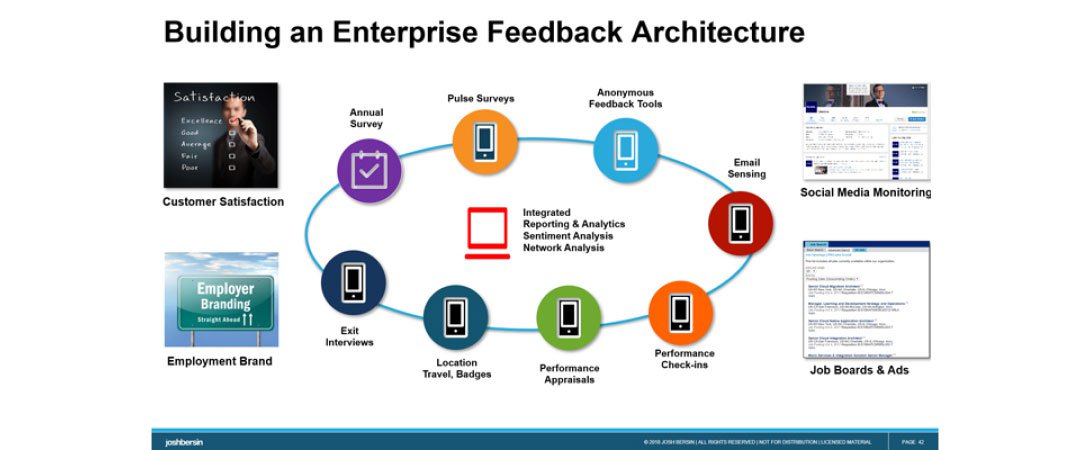Latest trends in employee mood measurement
18.03.2019 | Tom Haak

Not too long ago the main instrument to gather data about the mood of the employees in the different parts of the organisation was the annual employee engagement survey. Once per year, or one every two-years, a long questionnaire was distributed to the employees. 50-70% of the employees responded.
The answers were analysed and often months later the reports were ready. Management discussed the outcomes, and a summary was communicated to the employees. Focus groups discussed the outcomes and made some suggestions for management. And so on, and so on. Even writing the complete process down, takes too long. Employee mood measurement has fortunately moved on. Nine trends we see.
1. From annual survey to real time listening
The frequency in gathering the view of employees has increased. Gallup and some others started with short pulse surveys decades ago, and in the last years using pulse surveys has become a lot more common. There are many vendors that provide technology that makes it easier to administer pulse surveys (like CultureAmp, Peakon and Vibecatch).
Also organisations that used to focus on the traditional annual survey market, have innovated a lot and now offer pulse surveys and other advanced employee listening tools as well (like Effectory and Willis Towers Watson).
“Continuous listening” is the next phase in the evolution, but the tools that can help with continuous real-time listening are still limited. Solutions like Keencorp and StatusToday look interesting, both use e-mail traffic (in different ways) to get an idea of the temperature and the risks in the organisation.
2. From active to passive
In most employee mood measurement solutions, employees still have to answer one or more questions. In super simple solutions (like Celpax and MoodApp) it is only one question (“How was your day?” or “How are you feeling today?”), generally it is 5-15 questions. Some solutions (e.g. Peachy Mondays) offer adaptive surveys: if everything is ok, the survey is short, if some issues are sensed more questions are asked.
A question is, when employees will start to show survey-fatigue. Once the newness of the cool pulse app has worn off, employees might get more hesitant to answer questionnaires regularly, even if they are short.
Detecting employee mood in a passive way is more difficult. I already mentioned Keencorp and StatusToday, that do not require completed questionnaires, but use company e-mail as the input to produce insights on department level (protecting the privacy of individual e-mail users). Using face analysis and personal trackers is probably the next step.
3. From one-way to interactive two-way
Asking questions and gathering data is one, taking visible action is often not so easy. Most solutions are still kind of one-way. The organisation asks questions, and the employees have to hope that actions are taken on the issues they have flagged. Employees will sometimes wonder, if their input is really valued and taken into account.
Some solutions are more focused on facilitating a two-way dialogue. I came across CircleLytics, and they have development intelligent software to use the wisdom of the employees to tackle important issues, such as “How do we increase diversity in our organisation?” or “What could we do to enter the Asian market faster? Many organisations stimulate old fashioned boss-employee conversations. This is excellent practice of course, but it is difficult to aggregate the outcomes of these conversations.
4. Combining data sources
In his excellent article “Employee Engagement 3.0: Humu launches nudge engine” Josh Bersin included a picture (see below) that illustrates the trend to use data from multiple sources to sense what is going on in the organisation.
With the technology of today, it has become easier to integrate, connect and analyse the data from the various sources, and relate people data to business data. The use of clever sensors (see for example Humanyze, and examples of smart clothing) can be added to the mix.

5. Following the employee journey
Many organisation are focusing more on improving the employee experience. The employee journey is an often-used metaphor to visualise the lifecycle of an employee in an organisation. By following the way Marketing is measuring and tracking the customer journey, HR starts to use their measurement tools to capture how employees experience critical moments in their journey. Examples of common critical moments are: the first contact with the organisation on the career website, the interview with HR, the first day on the job, the onboarding period and the way at the end of the journey the exit is handled.

6. From mood measurement to risk measurement
What do you want to measure? Once we talked about Employee Satisfaction. Satisfaction changed to Engagement, and today Happiness and Experience are fashionable. Slowly, we also see Risk entering the scene. Wouldn’t it be nice if we could use our instruments to detect risks related to people in the organisation?
Claro claims that with their technology you can calculate the chance that an employee is interested in a new job (the Claro J-score). The Keencorp technology has been used to analyse Enron e-mails (that can be found on the internet), and they could have sensed the risks in the Enron organisation a lot earlier than that they appeared above water. Compliance to health & safety regulations is another area, where you would like to have an early detection mechanism of possible issues.
7. More focus on benefits for the employees
For many organisations a real focus on the employees seems far away. The use of mood measurement tools is very much focused on the benefits for the organisation. If you look at the picture of Josh Bersin under point 4, this is very clear. “Building an Enterprise Feedback Architecture” sounds very corporate and not very employee-centric. “Employee Listening Technology” can also have a negative connotation. Employees can become skeptical if the organisations are installing a sophisticated “Enterprise Feedback Architecture”. Will they use the data to better control and monitor us, or will they use the outcomes to enhance our organisational life? Yes, they are listening, but only listening is not enough!
Listening tools that are used to unleash the creativity and the collective power of the employees (as the mentioned CircleLytics) on face value have more benefits for the employees.
8. Start simple
For start-ups and scale-ups it does not make sense to build an Enterprise Feedback Architecture. You can start very simple. Many smaller organisations use Slack, and within Slack there are various simple plugins you can use to create a simple survey within minutes (as Polly, Happster Feedback and Simple Poll).
9. The HR dashboard
Recently I spent some time in a big retail organisation. Sales and Operations were more or less full-time behind their dashboards. What is selling and what not? Are the trucks on their way to the right shops? How are the new products selling? What is the level of customer complaints and how is NPS in the call center developing? The HR team was not yet at this level. Unfortunately, their dashboard was a quarterly dashboard, so looking at it on a daily basis made no sense. Only the recruitment team was further ahead, they at least had a good view on the number of vacancies and the candidates in the pipeline.
The HR landscape is changing. The sense of urgency is increasing, and with the technology and tools of today many HR teams will be able to use their dashboards daily and increase their impact on the organisation.
See also HR Trend Institute.


